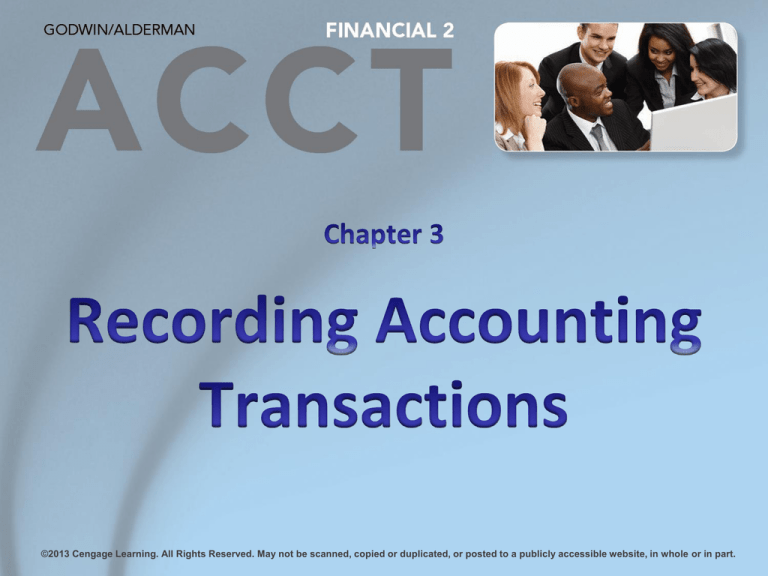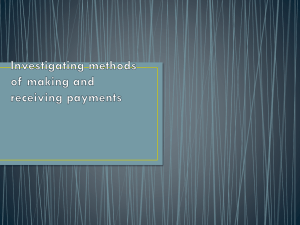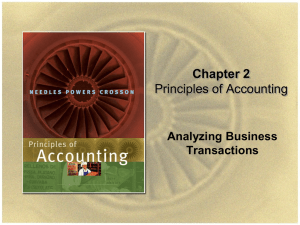
©2013 Cengage Learning. All Rights Reserved. May not be scanned, copied or duplicated, or posted to a publicly accessible website, in whole or in part.
Learning Objectives
1.Describe the purpose of an accounting
information system.
2. Analyze the effect of accounting
transactions on the accounting equation.
3.Understand how T-accounts and debits
and credits are used in a double entry
accounting system.
4.Describe the purpose of the journal,
ledger, and trial balance.
Learning Objectives
5. Record and post accounting
transactions and prepare a trial balance
and financial statements.
LOI
The Accounting
Information System
A company’s accounting information
system is the system that: identifies,
records, summarizes, and communicates the
various transactions of a company.
Accounting information systems vary widely,
ranging from manual, pencil-and-paper
systems in some organizations to highly
complex electronic systems in other
organizations.
Key Components in the Process to
Capture Accounting Information
Accounting Transaction—any economic event
that affects a company’s assets, liabilities or
equity at the time of the event.
Account—an accounting record that
accumulates the activity of a specific item and
yields the item’s balance.
Chart of Accounts—the list of accounts that a
company uses to capture its business.
[
Chart of Accounts Example
Chart of Accounts
100 - 199
ASSETS
100
101
110
120
200 - 299
210
211
230
300 - 399
300
350
400 - 499
400
500 - 599
501
502
600 – 699
Cash
Accounts Receivable
Supplies
Equipment
LIABILITIES
Accounts Payable
Unearned Revenues
Notes Payable
EQUITY
Common Stock
Retained Earnings
REVENUES
Service Revenue
EXPENSES
Wage Expense
Interest Expense
DIVIDENDS
LO2 Accounting Transactions and
the Accounting Equation
All accounting transactions must be recorded in the
accounting information system. To understand the
nature of recording transactions, it is best to start
with the fundamental accounting equation:
The Basic Accounting Equation
Assets
=
Liabilities
+
Equity
Assets must always equal the sum of its liabilities and equity.
Any change to the equation must be accompanied by a second
change.
Dual Nature of Accounting
If a transaction
increases an asset
account.
For the equation to
stay in balance, the
transaction must
either decrease
another asset
account or increase a
liability or equity
account.
8
Transaction # 1
After incorporating, Circle Films issues 3,000 shares of
common stock to investors for $15,000 cash.
Assets
Cash
Prior Bal
=
Liabilities
=
+
+
Equity
Common
Stock
$0
$0
#1
+$15,000
+$15,000
New Bal
$15,000
$15,000
=
$0
+
$15,000
$15,000
Transaction #2
Circle Films purchases a video camera for $9,000 and
memory cards for $1,000.
Assets
Cash
Prior
Bal
#2
New
Bal
=
Supplies
Equipment
$15,000
$0
$0
-$10,000
+$1,000
+$9,000
$5,000
$1,000
$9,000
$15,000
Liabilities
=
+
Equity
Common
+ Stock
$15,000
$15,000
=
$0
+
$15,000
Transaction #3
Circle Films receives a $1,500 payment immediately after
filming a customer’s wedding.
Assets
Prior Bal
#3
New Bal
Cash
$5,000
+$1,500
$6,500
Supplies
$1,000
$1,000
$16,500
= Liabilities +
Equipment =
$9,000
$9,000
=
$0
Equity
Common Retained
+ Stock
Earnings
$15,000
$0
+$1,500
$15,000
$1,500
+
$16,500
Transaction # 4
Circle Films receives a $2,000 deposit from a customer to
film her parents’ 50th wedding anniversary.
Assets
Cash
Prior
Bal
#4
New
Bal
$6,500
Supplies
$1,000
=
Liabilities
Unearned
Equipment = Revenue
$9,000
Equity
Common Retained
+ Stock
Earnings
$0
+$2,000
$8,500
+
$15,000
$1,500
$15,000
$1,500
+$2,000
$1,000
$18,500
$9,000
$2,000
=
$2,000
+
$16,500
Transaction # 5
Circle Films paid $250 cash to run an ad in the local
paper.
Assets
Prior Bal
#5
New Bal
Cash
$8,500
-$250
$8,250
Liabilities
Unearned
Supplies Equipment = Revenue
$1,000
$9,000
$2,000
$1,000
$18,250
=
$9,000
=
$2,000
$2,000
+
Equity
Common Retained
+ Stock
Earnings
$15,000
$1,500
-$250
$15,000
$1,250
+
$16,250
Transaction # 6
Circle Films films a dance competition, leaving a $3,500
invoice with the customer.
Cash
Prior
Bal
#6
New
Bal
$8,250
Assets
Accounts
Receivable Supplies
$0
$1,000
=
Equipment =
$9,000
Liabilities
Unearned
Revenue
+
Equity
Common Retained
+ Stock
Earnings
$2,000
$15,000
+$3,500
$8,250
$3,500
$1,250
+$3,500
$1,000
$21,750
$9,000
$2,000
=
$2,000
$15,000
+
$4,750
$19,750
Transaction # 7
Circle Films purchases another $9,000 video camera by
signing a two-year promissory note requiring the payment
of principal and interest at maturity. Interest is charged at a
6% annual rate.
Cash
Prior
Bal
#7
New
Bal
$8,250
Assets
Accounts
Rec.
Supplies
$3,500
$1,000
=
Liabilities
+
Equity
Unearned
Notes
Common Retained
Equipment = Revenue Payable + Stock
Earnings
$9,000
$2,000
+$9,000
$8,250
$3,500
$1,000
$30,750
$0
$15,000
$4,750
$15,000
$4,750
+$9,000
$18,000
$2,000
=
$11,000
$9,000
+
$19,750
Transaction # 8
Circle Films receives $3,500 from the customer in payment
of the open invoice from transaction #6.
Prior
Bal
#8
New
Bal
Cash
Assets
Accts
Rec.
Supplies
$8,250
$3,500
+$3,500
-$3,500
$11,750
$0
$30,750
=
Equip.
Liabilities
+
Equity
Unearned Notes
Common
Retain
= Revenue
Pay
+ Stock
Earnings
$1,000 $18,000
$2,000
$9,000
$15,000
$4,750
$1,000 $18,000
$2,000
$9,000
$15,000
$4,750
=
$11,000
+
$19,750
Transaction # 9
Circle Films pays wages of $2,000 to its employees.
Assets
Cash
Prior
Bal
#9
New
Bal
$11,750
Accts
Rec.
Supplies
$0
$1,000
=
Equipment
Liabilities
+
Equity
Unearned Notes
Common Retained
= Revenue
Pay
+
Stock
Earnings
$18,000
$2,000
$9,000
$15,000
-$2,000
$9,750
$4,750
-$2,000
$0
$1,000
$28,750
$18,000
$2,000
=
$9,000
$11,000
$15,000
+
$17,750
$2,750
Transaction # 10
At the end of the month, Circle Films pays its owners a
$1,500 cash dividend.
Assets
Cash
Prior
Bal
#10
New
Bal
$9,750
Accts
Rec.
Supplies
$0
$1,000
=
Liabilities
+
Equity
Unearned Notes
Common Retained
Equipment = Revenue
Pay
+ Stock
Earnings
$18,000
$2,000
$9,000
$15,000
-$1,500
$8,250
$2,750
-$1,500
$0
$1,000
$27,250
$18,000
$2,000
=
$9,000
$11,000
$15,000
+
$1,250
$16,250
LO3
The Double-Entry
Accounting System
Every accounting
transaction affects
at least two
accounts.
Account Name
Debit
Side
Credit
Side
Any combination
affecting assets,
liabilities, and equity
can occur, as long as
the accounting
equation stays in
balance.
All accounts can be represented in the form
known as a T-account shown above. The left side
of the account is known as the debit side and the
right side of the account is the credit side.
Debit and Credit Rules
Debit (Dr.)
Credit (Cr.)
• means to “record an
entry on the left side of
an account.”
A debit indicates:
1) an increase in an asset,
2) a decrease in a liability,
or
3) a decrease in a
shareholders’ equity.
• means to “record an
entry on the right side of
an account.”
A credit indicates:
1) a decrease in an asset,
2) an increase in a liability,
or
3) an increase in a
shareholders’ equity.
T-Account Normal Balances - Assets
• Increases in assets
appear on the left side.
The Company
receives $100
Cash from a
customer
• Decreases in assets appear
on the right side of Taccounts.
Cash
100
50
The Company
pays $50 Cash
to a vendor.
T-Account Normal Balances – Liabilities
• Decreases in liabilities
appear on the left side.
The Company
pays its
suppliers the
$25 it owed
them.
• Increases in liabilities
appear on the right side of
T-accounts.
Accounts Payable
25
75
The Company
agreed to pay
suppliers $75
for items
purchased.
T-Account Normal Balances –
Equity
• Decreases in
Stockholders’ Equity
appear on the left side.
• Increases in
Stockholders’ Equity
appear on the right side
of T-accounts.
The Company Common Stock
retires $45
45
95
stated value
common stock.
The Company
issues $95
stated value
common stock.
Changes in Account Balances
To increase an
account
balance: Record
on the same side
as the normal
balance.
To decrease an
account
balance: Record
on the opposite
side as the
normal balance.
Debit and Credit Summary Chart
Type of
Account
Asset
Liability
Equity
Revenue
Expense
Dividend
Normal
Balance
Debit
Credit
Credit
Credit
Debit
Debit
Increase
with a
Debit
Credit
Credit
Credit
Debit
Debit
Decrease
with a
Credit
Debit
Debit
Debit
Credit
Credit
End of Lecture
LO4
Journal, Ledger,
and Trial Balance
Journal is a chronological record of transactions. Because
the journal is where transactions are first recorded into the
accounting system, it is often called the book of original
entry. Entries recorded in the journal are called journal
entries.
Ledger is a collection of accounts and their balances.
Trial balance is a listing of accounts and their balances at
a specific point in time.
Journal Entries
The following standardized format indicates
the accounts and amounts, with debits on the
first line and credits (indented) on the second
line:
Date Account Debited……………………
Account Credited……………..
Amount Debited
Amount Credited
LO5
Recording Transactions
Into the Accounting System
Instead, accounting transactions
are first recorded in a journal.
Accounting transactions are not
recorded directly into the Taccounts.
Account Name
Debit
Side
Credit
Side
GENERAL
JOURNAL
Date
Dec
Description
1
Cash
Debit
1,350
Unearned Rent Revenue
Dec
31
Unearned Rent Revenue
Rent Revenue
Credit
1,350
450
450
Ledger
To get an account balance, one would have to find all journal
entries affecting that account and then compute a balance.
To avoid such a time consuming task, the information
recorded in the general journal is transferred to a ledger.
The general ledger is really nothing more than a
collection of T-accounts for a company, which
means that the general ledger contains both the
activity and balances of all company accounts.
The most basic type of ledger is the general ledger.
Posting to Ledger
GENERAL
JOURNAL
Date
Dec
Description
1
Cash
Debit
1,350
Unearned Rent Revenue
Dec
31
Cash
1,350
1,350
Unearned Rent Revenue
Rent Revenue
Unearned Rent
Revenue
450
1,350
900
Credit
1,350
450
450
Rent Revenue
450
450
Step 1 – What accounts are affected and how are they affected?
Step 2 – What debit and credit entries are required?
Step 3 – Record the journal entry.
Step 4 –Transfer the information to the ledger. This process of copying or
transferring the information from the journal to the ledger is called posting.
Trial Balance
Asset Account(s)
Liability Account(s)
Equity Account(s)
Revenue Account(s)
Expense Account(s)
Dividends
Trial Balance
Debit
Dollar amount
Credit
Dollar amount
Dollar amount
Dollar amount
Dollar amount
Dollar amount
Total debits
Total Credits
Trial Balance Functions
Equal
Totals
Summarizes
Accounts and
Balances in one
place
Helps in
making any
account
adjustments
Comprehensive Example: Journal
Entries to Financial Statements
The next series of slides use transactions
from Circle Films to demonstrate the
recording of transactions in the journal, the
posting of information to the general
ledger, the preparation of a trial balance,
and the preparation of financial
statements.
Transaction # 1
Circle Films issued 3,000 shares of common stock for
$15,000.
General Journal
Transaction
#1
Cash
0
15,000
15,000
Account Names and Explanation
Cash
Common Stock
(Owners invest cash in business)
Debit
15,000
Credit
15,000
Common Stock
0
15,000
15,000
Transaction # 2
Circle Films buys a $9,000 video camera and $1,000 of
memory cards for $10,000 cash.
General Journal
Transaction
Account Names and Explanation
#2
Equipment
Supplies
Cash
(Purchase video camera and tapes)
Cash
0
15,000 10,000
5,000
Supplies
0
1,000
1,000
Debit
9,000
1,000
Credit
10,000
Equipment
0
9,000
9,000
Transaction # 3
Circle Films films a wedding for $1,500 cash.
General Journal
Transaction
#3
Account Names and Explanation
Cash
Service Revenue
(Provide service to customer)
Cash
0 10,000
15,000
1,500
6,500
Debit
1,500
Credit
1,500
Service Revenue
0
1,500
1,500
Transaction # 4
Circle Films receives $2,000 to film a future reception.
General Journal
Transaction
#4
Account Names and Explanation
Cash
Unearned Revenue
(Cash received in advance of
providing service to customer)
Cash
0 10,000
15,000
1,500
2,000
8,500
Debit
2,000
Credit
2,000
Unearned
Revenue
0
2,000
2,000
Transaction # 5
Circle Films pays $250 cash for advertising.
General Journal
Transaction
Account Names and Explanation
#5
Advertising Expense
Cash
(Pay for advertising)
Cash
0 10,000
15,000 250
1,500
2,000
8,250
Debit
250
Credit
250
Advertising
Expense
0
250
250
Transaction # 6
Circle Films films an event for $3,500 and leaves an
invoice with the customer.
General Journal
Transaction
#6
Accounts Receivable
0
3,500
3,500
Account Names and Explanation
Accounts Receivable
Service Revenue
(Provide service to customer
on account)
Debit
3,500
Credit
3,500
Service Revenue
0
1,500
3,500
5,000
Transaction # 7
Circle Films buys another camera by signing a $9,000
promissory note.
General Journal
Transaction
#7
Account Names and
Explanation
Equipment
Notes Payable
(Purchase of a video camera
with a promissory note)
Equipment
0
9,000
9,000
18,000
Debit
Credit
9,000
9,000
Notes Payable
0
9,000
9,000
Transaction # 8
Circle Films receives $3,500 from a customer in
payment of services provided by Circle.
General Journal
Transaction
#8
Account Names and
Explanation
Debit
Cash
Accounts Receivable
(Receive payment from
customer)
3,500
Cash
0 10,000
15,000 250
1,500
2,000
3,500
11,750
Credit
3,500
Accounts
Receivable
0 3,500
3,500
0
Transaction # 9
Circle Films pays $2,000 in wages to employees.
General Journal
Transaction
#9
Account Names and
Explanation
Wage Expense
Cash
(Pay wages to employees)
Cash
0 10,000
15,000 250
1,500 2,000
2,000
3,500
9,750
Debit
Credit
2,000
2,000
Wage Expense
0
2,000
2,000
Transaction # 10
Circle Films pays $1,500 in dividends to the owners.
General Journal
Transaction
#10
Account Names and
Explanation
Dividends
Cash
(Pay dividends to owners)
Cash
0 10,000
15,000 250
1,500 2,000
2,000 1,500
3,500
8,250
Debit
Credit
1,500
1,500
Dividends
0
1,500
1,500
Trial Balance
The trial balance presents a summary of the balances
in the ledger. Notice that total debit balances equal
total credit balances in the trial balance.
Circle Films
Trial Balance
May 31
Cash
Supplies
Equipment
Unearned Revenue
Notes Payable
Common Stock
Service Revenue
Advertising Expense
Wage Expense
Dividends
Totals
Debit
$8,250
1,000
18,000
Credit
$2,000
9,000
15,000
5,000
250
2,000
1,500
$31,000
$31,000
Income Statement
Circle Films
Income Statement
For the month ending May 31
Service Revenue
Expenses:
Advertising Expense $250
Wage Expense
2,000
Total Expenses
Net Income
$5,000
2,250
$2,750
Statement of Retained Earnings
Circle Films
Statement of Retained Earning
For the month ending May 31
Retained Earnings, May 1
$0
+ Net Income
2,750
- Dividends
1,500
Retained Earnings, May 31
$1,250
Balance Sheet
Circle Films
Balance Sheet
May 31
Cash
Supplies
Equipment
Total Assets
Unearned Revenue
Notes Payable
Total liabilities
Common Stock
Retained Earnings
Total Stockholders’ Equity
Total Liabilities and
Stockholders’ Equity
$8,250
1,000
18,000
$27,250
$2,000
9,000
$11,000
15,000
1,250
$16,250
$27,250
End of Chapter 3










